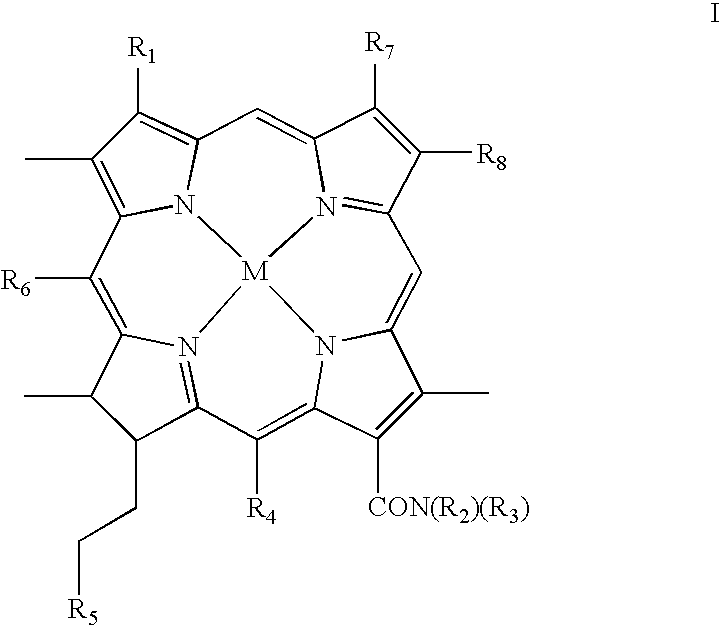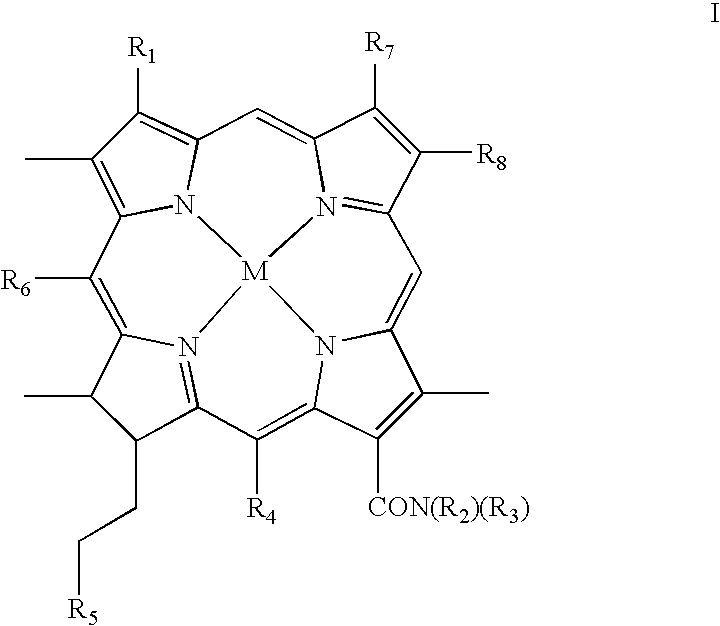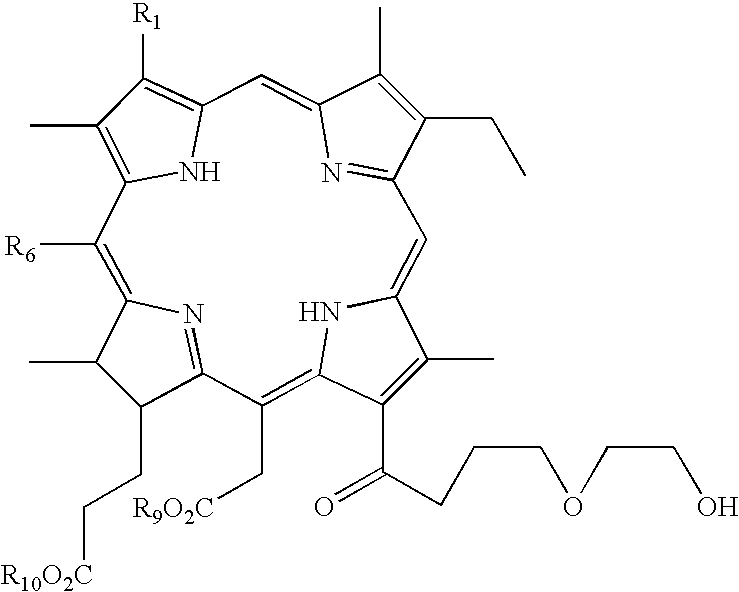Chlorin photosensitizing agents for use in photodynamic therapy
- Summary
- Abstract
- Description
- Claims
- Application Information
AI Technical Summary
Benefits of technology
Problems solved by technology
Method used
Image
Examples
example 1
3-[[(3-hydroxypropyl)amino]carbonyl]-13-ethenyl-18-ethyl-7,8-dihydro-5-(2-methoxy-2-oxoethyl)-2,8,12,17-tetramethyl-21H, 23H-Porphine-7-propionic acid, methyl ester (30)
Methyl pheophorbide (0.5 g) was dissolved in dichloromethane (10 mL) and aminopropan-3-ol (0.5 g) was added. The reaction was stirred overnight at room temperature and the solvent reduced to a volume of ˜2 mL by rotary evaporation. The solution was chromatographed on silica using 2% methanol / dichloromethane as eluent. The major green fraction was collected and crystallized from hexane / dichloromethane. Yield of title compound=0.6 g.
example 2
3-[[(3-hydroxypropyl)amino]carbonyl]-13-ethenyl-18-ethyl-7,8-dihydro-5-(acetic acid)-2,8,12,17-tetramethyl-21H, 23H-Porphine-7-propionic acid, (31)
To compound (30) (100 mg) dissolved in THF (50 mL) was added a solution of sodium hydroxide (200 mg) in water (1 mL). The solution was stirred at room temperature overnight and the THF removed by rotary evaporation. The residue was dissolved in water (4 mL) and acetic acid was added dropwise until the solution was neutral. Chloroform (200 mL) was added and the aqueous layer exhaustively extracted with chloroform. The organic layer was collected and dried over sodium sulfate and filtered. The solvent was reduced to ˜4 mL and the solution chromatographed on silica using 7-10% methanol dichloromethane as eluent. The major green band was collected and dried. Yield of title compound=70 mg.
example 3
3-[[(3-hydroxypropyl)amino]carbonyl]-13-ethenyl-18-ethyl-7,8-dihydro-5-(acetic acid)-2,8,12,17-tetramethyl-21H, 23H-Porphine-7-propionic acid, disodium salt (32)
To compound (31) (100 mg) was added a solution of sodium hydroxide (200 mg) in water (1 mL). The solution was stirred at room temperature for 1 hr and then loaded onto an ion exchange column (Amberlite, CG-50 ion exchange resin, weakly acidic, sodium form). The green band was collected and lyophilized. Yield of title compound=110 mg.
PUM
| Property | Measurement | Unit |
|---|---|---|
| Mass | aaaaa | aaaaa |
| Fraction | aaaaa | aaaaa |
| Time | aaaaa | aaaaa |
Abstract
Description
Claims
Application Information
 Login to View More
Login to View More - R&D
- Intellectual Property
- Life Sciences
- Materials
- Tech Scout
- Unparalleled Data Quality
- Higher Quality Content
- 60% Fewer Hallucinations
Browse by: Latest US Patents, China's latest patents, Technical Efficacy Thesaurus, Application Domain, Technology Topic, Popular Technical Reports.
© 2025 PatSnap. All rights reserved.Legal|Privacy policy|Modern Slavery Act Transparency Statement|Sitemap|About US| Contact US: help@patsnap.com



